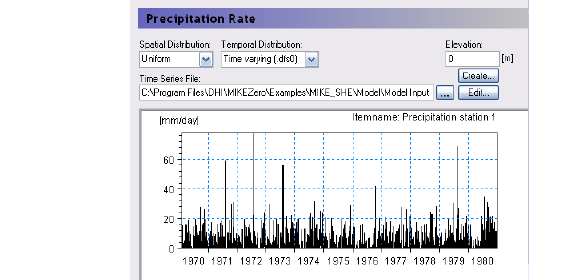

|
Precipitation Rate |
|
|---|---|
|
dialogue Type: |
|
|
Grid Code |
|
|
Time Series EUM Data Units |
Precipitation Rate [e.g. mm/hr], or Rainfall [e.g. mm] |
The precipitation rate is the measured rainfall, or snowfall in rainfall equivalent units.
You can specify the precipitation rate as a rate, for example in [mm/hr], or as an amount, for example in [mm]. If you use an amount, MIKE SHE will automatically convert it to a rate during the simulation.
If you use a rate, then the EUM Data Units must be Precipitation and the time series must be Mean Step Accumulated (V1 p. 150).
If you use an amount, then the EUM Data Units must be Rainfall and the time series must be Step Accumulated (V1 p. 149).
The Precipitation Rate item comprises both a distribution and a value. The distribution can be either uniform, station-based or fully distributed. If the data is station-based then for each station a sub-item will appear where you can enter the time series of values for the station.
If Include snow melt is included and the Air Temperature (V1 p. 236) is below the Threshold Melting Temperature (V1 p. 240), The threshold melting temperature is the temperature at which the snow starts to melt - usually 0 C. If the air temperature is above this threshold, then the snow will melt at the rate specified in the Degree-day Melting or Freezing Coefficient (V1 p. 241) item. If the air temperature falls belowthen the precipitation will accumulate as snow.
Elevation - This is the station elevation. It is used as the reference elevation if the cell-by-cell precipitation is to be corrected for elevation differences (See Elevation corrections (V1 p. 229)). The actual precipitation in each cell will then be calculated based on the elevation of the cell relative to the station elevation and the Precipitation Lapse Rate (V1 p. 232). Elevation correction is not available for fully-distributed precipitation data.
Related Items
· Precipitation Lapse Rate (V1 p. 232)
· Creating Time Series in MIKE SHE (V1 p. 145)
· Working with Spatial Time Series (V1 p. 147)
· Time Series Types (V1 p. 147)